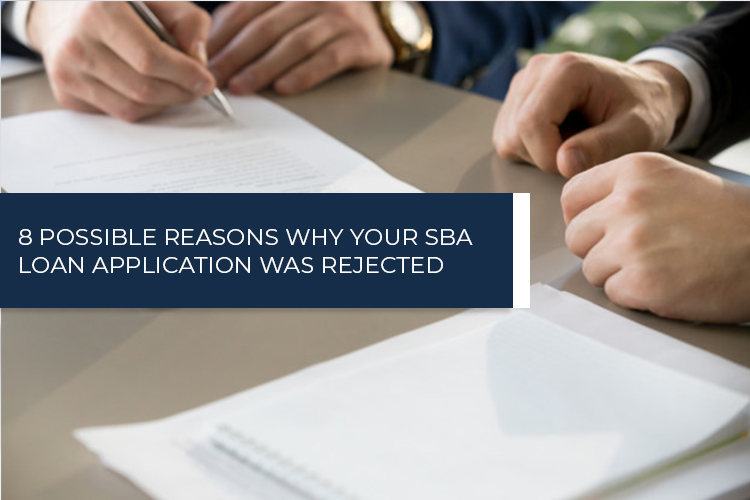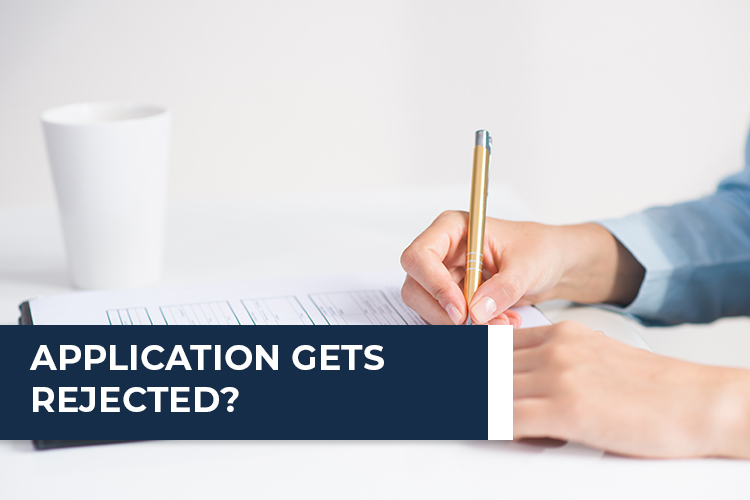8 Reasons Why Your SBA Loan Application Gets Rejected and What Can You Do About It!

The Coronavirus crisis has wreaked havoc on businesses all over the world. As business owners, you likely have had to cut costs, revise sales projections, and potentially seek out a loan to help you stay afloat. Fortunately, the SBA has created a separate COVID-19 Disaster Loan. This disaster loan has less stringent eligibility criteria and a streamlined application process. This is meant to make more funds available for more businesses.
But by no means does simplified mean assured. If you have recently applied for an SBA Economic Injury Disaster Loan (EIDL) and got denied, it’s not the end.
In this article, we’re taking a look at the top reasons that may have led to your application being denied. We’ll also go through the steps you can take to assure you secure funding on your second attempt.
8 Possible Reasons why your SBA Loan Application was Rejected

The problem with a simple application is that you likely won’t receive a specific answer explaining why you were ineligible. The criteria has been expanded to permit more people to apply. But the typical reasons due to which your application may be denied are quite common. Explore this list to figure out what is the potential weak point in your application.
1. You have a new business
Usually, banks won’t issue traditional SBA loans to businesses that are brand new. Traditional SBA loans often require you to have been in business for a couple of years. Moreover, even if they decide to lend to new companies or startups, they typically expect the owners to have experience in the industry.
The requirements for the COVID-19 Disaster Loans are a bit different. Your business should have been running long enough to show financials that prove that you were negatively affected by coronavirus. This does not imply that you’ll need documents of the last 2-3 years proving your revenue and cost of goods sold. But, in all likelihood, you will need reports that show at least 12-months of financial activity.
2. Your Credit Score is low
Although your credit score is not a criteria to qualify for a Disaster Loan, they’ll most likely still run a credit check during the approval process. You must have a strong credit score to qualify for a traditional SBA loan. Most banks require you to have a credit score of at least 600.
The required credit score depends on which lender you choose. Chances are that it might not be as high when applying for a Disaster Loan.
3. You lack proper Collateral
During an economic slowdown, banks become especially risk-averse. They want to protect themselves in case a business owner cannot pay back a loan. They want you to put up some collateral as assurance which they can use to recover their money, even if your business folds. Despite the fact that SBA backs up to 75% of SBA loans, the bank is still on the line for the other 25%. You can find out all you need to know about SBA loans through our blog.
4. You have high or low debt utilization
High or low credit utilization can be a major cause of concern for lenders. If you have outstanding loans or a line of credit that’s almost maxed out, you are a much riskier applicant.
The contrasting position is also not good. If you’ve never taken on debt or lack a visible credit history, lenders cannot determine if you’ll handle the loan responsibly. So, if you have outstanding debt, we suggest that you try to pay it down. If you lack a visible credit history, build that up by applying for smaller lines of credit and regularly paying it off.
5. Your Cash Flow is poor
Consistent and healthy cash flow reports are important to get approved for an SBA loan. Such reports of a few months can potentially supplement long-term financial reports for young businesses.
But the presence of any cash flow issues may result in your application getting rejected. Lenders look at cash flow when determining your eligibility. This is the reason why one of the recommended documents to be included with SBA applications is your previous years’ cash flow statement. They’re looking to analyze your burn rate and cash runway to determine how likely you are to pay back the loan. During a crisis, a hit in sales, revenue, or overall cash flow can help conclusively prove that you were affected by COVID-19.
6. Your industry is Risky
Some lenders might be less willing to approve your loans if you operate in “risky” industries. Restaurants, retail, real estate, and lending services are a few examples of business types that might be considered risky. These businesses may experience greater difficulty in securing a loan. But, if you present strong pre-crisis financials, a thorough business plan, and you’re a specialist in your industry, then it can increase your chances of getting approved.
Apart from risky industries, some industries are excluded from SBA loans, irrespective of your application’s merit. Industries that are excluded include life insurance companies, lobbying organizations, cannabis-based businesses, certain types of health businesses, and more.
7. Your application is incomplete or documents are missing
Submitting an incomplete application is a surefire way to get your load application denied. Similarly, not submitting all the necessary documents will also lead to your application being rejected.
The SBA Economic Injury Disaster Loan (EIDL) application has been streamlined to a simple online form. This reduces the chances of you submitting an application without all the necessary info.
Moreover, your specific lender may require several additional documents to process the loan application. You must be extra careful about this so that you don’t miss something when applying. It’s always good to double-check everything before submitting.
8. You violate some specific requirements
All loans have their own specific requirements associated with them. You must thoroughly check whether you fall within the requirements of the lender. Also ensure that there are no additional documents or application materials that you have missed for this specific loan.
What can you do if your application gets rejected?

Look for an alternate Lender
Maybe the lender you chose wasn’t the best fit for your business or your specific situation. If that’s the case, you have more options apart from giving up or reapplying. You should check out other approved lenders that might be better for your business. Chances are that approaching a different kind of financial organization would increase your probability of getting your loan approved. There are plenty of options available for every business and all you need to do is research and find the best one for you.
Explore Alternative sources of Funding
Cannot qualify for the loan that you wanted? If yes, then you might want to explore other funding options. There are a lot of financial organizations that provide alternative financing. Remember that the qualifications may be relaxed but you’ll likely have to supply greater collateral or work with a higher interest rate.
Reassess and Reanalyze your Forecasts
Revisit your forecasts regularly even if you’re not applying for a loan. In doing so, you might come across some alternative cost-cutting solutions that don’t require outside funding. You can also develop more comprehensive financial forecasts that help represent your business with future applications. You should work through, revise, and test different scenarios so that you can be more prepared to handle uncertainty.
Final Words
It is really important to have clear financial and operational documents when you’re applying or reapplying for a business loan. A comprehensive and updated business plan will help you avoid all kinds of issues in your loan application. You can also use the business plan as a management tool to assess the financial health of your business.
There are many reasons due to which your SBA loan application can be rejected. We hope that this article was able to shed some light on the issue and helped you figure some things out.
If you’ve got any questions you can let us know in the comments below or write to us and we’ll get back to you at the earliest!


Write a reply or comment
You must be logged in to post a comment.